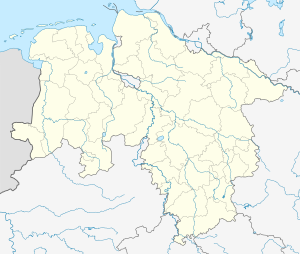Elbe Lateral Canal Tunnel
|
Elbe Lateral Canal Tunnel Calberlah tunnel
|
||
|---|---|---|
| use | Railway tunnel | |
| traffic connection | Berlin-Lehrter Railway | |
| place | Calberlah | |
| length | 965 m | |
| Number of tubes | 1 | |
| business | ||
| operator | DB network | |
| release | 1974 | |
| location | ||
|
|
||
| Coordinates | ||
| West portal | 52 ° 26 '14 " N , 10 ° 35' 44" E | |
| East portal | 52 ° 25 ′ 55 ″ N , 10 ° 36 ′ 25 ″ E | |
The Elbe Lateral Canal Tunnel , also known as the Calberlah Tunnel , is the only railway tunnel on the Berlin – Lehrte line ( high-speed line Hanover – Berlin ). The 965 meter long tunnel crosses under the Elbe Lateral Canal west of the Lower Saxon community of Calberlah (near Wolfsburg ) and therefore bears his name.
The structure was erected as part of the construction of the Elbe Lateral Canal and opened to traffic in 1974. It takes up two tracks on a ballasted superstructure that can be driven on at up to 200 km / h.
construction
The tunnel was constructed using the cut- and- cover method as a framework and was put into operation in 1974. The construction company Jürgen Martens from Hamburg had received the contract to build the tunnel .
course
The tunnel is located west of the municipality of Calberlah, around 13 kilometers west of Wolfsburg Central Station . The route of the tube runs in a north-west-south-east direction. At the eastern end of the tunnel, the Elbe Lateral Canal and at the western end the district road 117 are crossed.
On both sides of the portals between the route kilometers 193.405 (east portal) and 194.370 (west portal), around 500 m long trough structures are attached. The total length of the structure is 1985 m, its width 14.5 meters.
business
The tunnel is used by long-distance and regional passenger trains as well as freight trains. The southern track (used by trains in the direction of Berlin as planned) can be used at speeds of up to 200 km / h, while the northern track (status: timetable year 2019/2020) has a short slow speed section of 120 km / h incorporated into the timetable ( Route km 192.6 to 192.8).
technology
The pipe is drained via a sewer line and a pump house at the east portal.
In the course of the realization of the high-speed line Hanover-Berlin, a line train control system for high-speed trips was installed in the 1990s . Cell phone reception is now possible in the tunnel using a special antenna .
As part of a program to improve safety in existing rail tunnels, the tube was later equipped with escape routes on both sides , fire-fighting water pipes and safety lighting (longitudinal distance of the lamps: 18 m), and rescue areas were set up at both portals. The Calberlah volunteer fire brigade was also equipped with a road - rail fire engine that can be put on the rails in Gifhorn or Fallersleben. The main reason for including the shortest tunnel with 970 m in the retrofitting program comprising 14 tubes was the unrestricted mixed operation of fast passenger and freight trains as envisaged in the operating program and the unfavorable location of the portals.
The extinguishing water supply on the east side is ensured from the Elbe Lateral Canal in an emergency. There is a cistern on the west side . If the cistern is exhausted, a stretch of hoses can be built from a hydrant on Haustenbecker Strasse (approx. 300 m) or from the Elbe side canal (approx. 1000 m).
Individual evidence
- ↑ a b Deutsche Bahn AG, Emergency Management / Fire Protection: Fire and Disaster Protection in Railway Tunnels ( Memento of the original from March 31, 2010 in the Internet Archive ) Info: The archive link was automatically inserted and not yet checked. Please check the original and archive link according to the instructions and then remove this notice. (PDF; 2.3 MB), August 2003, "Version 3", pp. 67, 72
- ↑ Half- sentence on upgrading without citing the source.

